Abstract
1. The directly evoked action potential of dissociated, embryonic, chick, dorsal root ganglion (DRG) neurones maintained in cell culture is prolonged compared to spinal cord cell spikes and the re-polarization phase is marked by a plateau. 2. Evidence was obtained that both Ca2+ and Na+ carry inward current across the active soma membrane. Ca2+ because: overshooting spikes persist in tetrodotoxin (TTX) or Na+-free media; in the presence of TTX (or absence of Na+) spike size varies directly with extracellular Ca2+ and spikes are eliminated by Co2+. Na+ because: spikes persist in the presence of Co2+ or Ca2+-free media; in the presence of Co2+ (or absence of Ca2+) spike varies directly with extracellular Na+ and spikes are blocked by TTX. 3. On the other hand, Ca2+ plays less if any role in action potentials conducted along sensory nerve cell processes. Conducted spikes could not be evoked in TTX containing or Na+-free media. 4. A long-lasting depolarization follows the action potential in some neurones. This depolarization is associated with an increase in membrane conductance and appears to drive the membrane potential to ca. -30mV. It persists when conducted impulses are blocked so it is probably not a recurrent synaptic potential. 5. It is suggested that combined Ca2+-Na+ spikes observed in isolated sensory neurones in vitro reflect the action potential of adult sensory cells but the possibility that they represent an early stage in development is also discussed.
Full text
PDF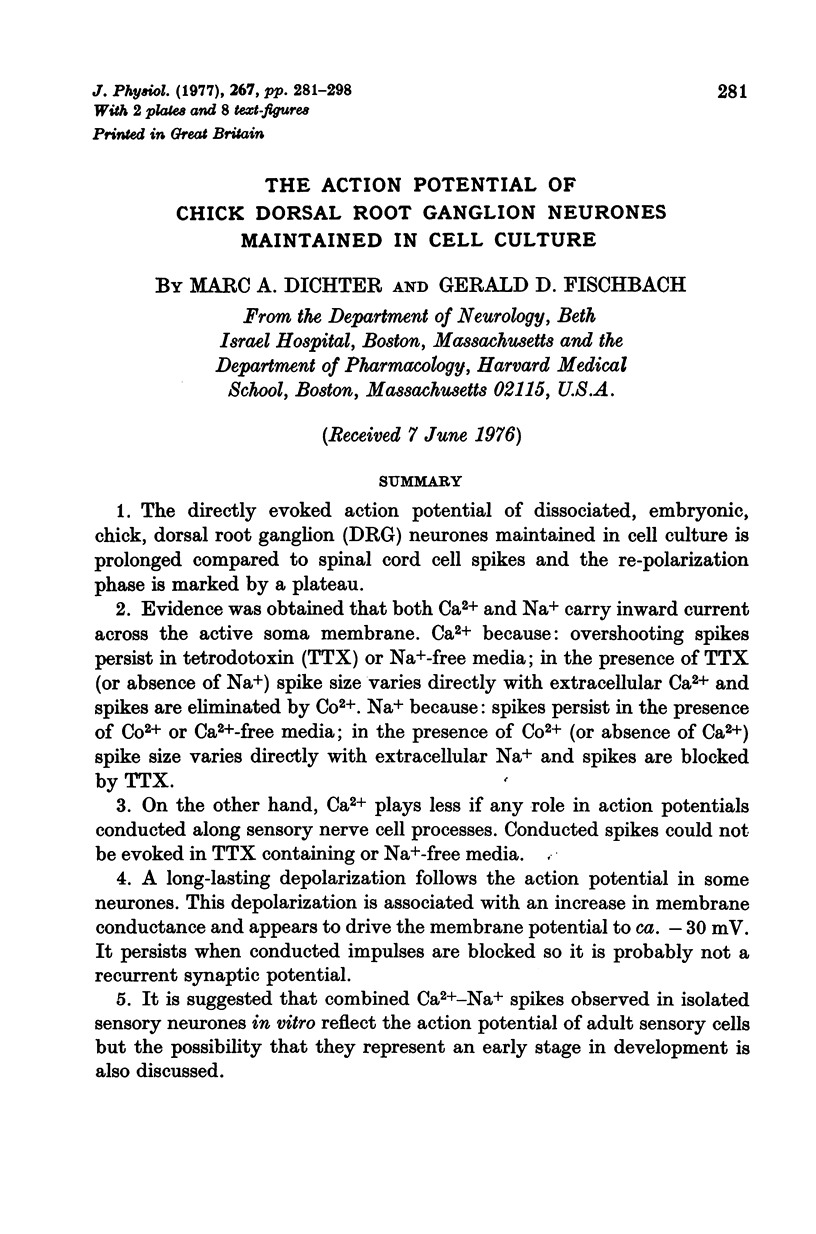



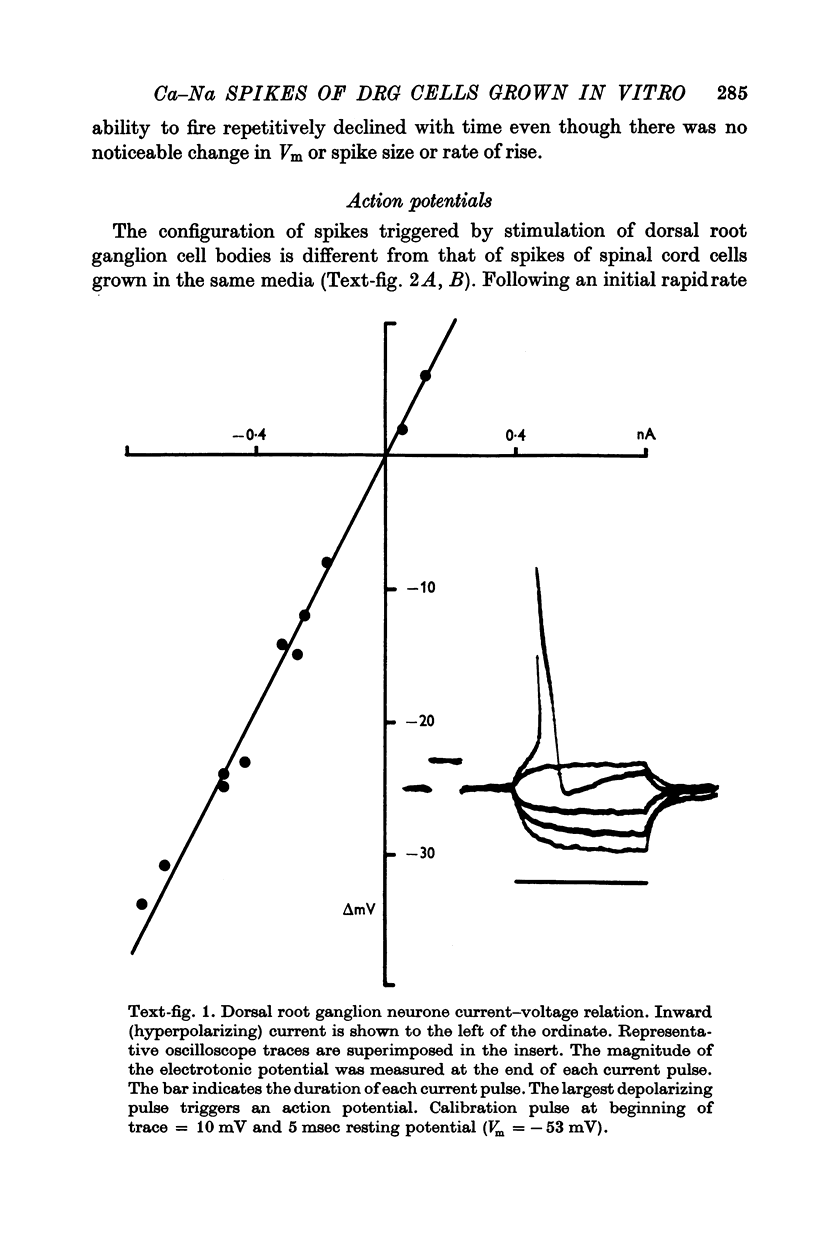



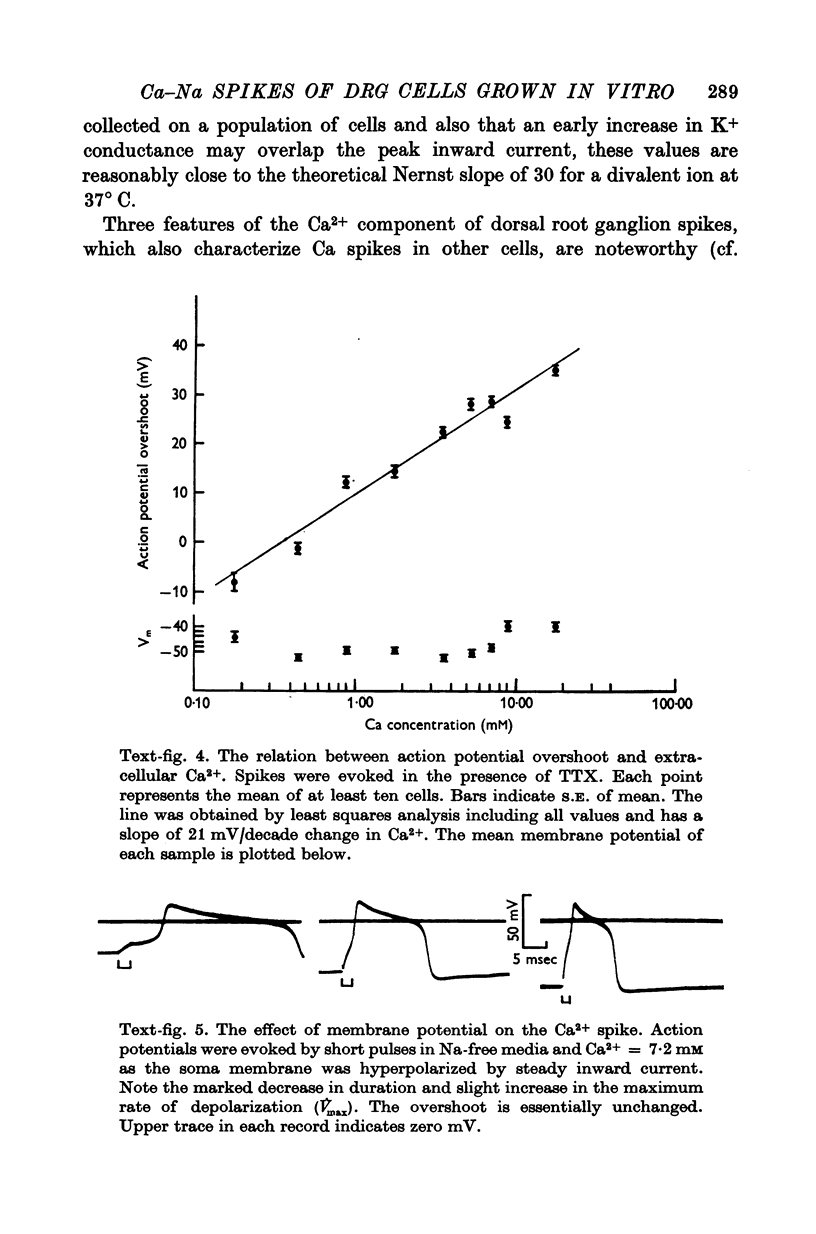
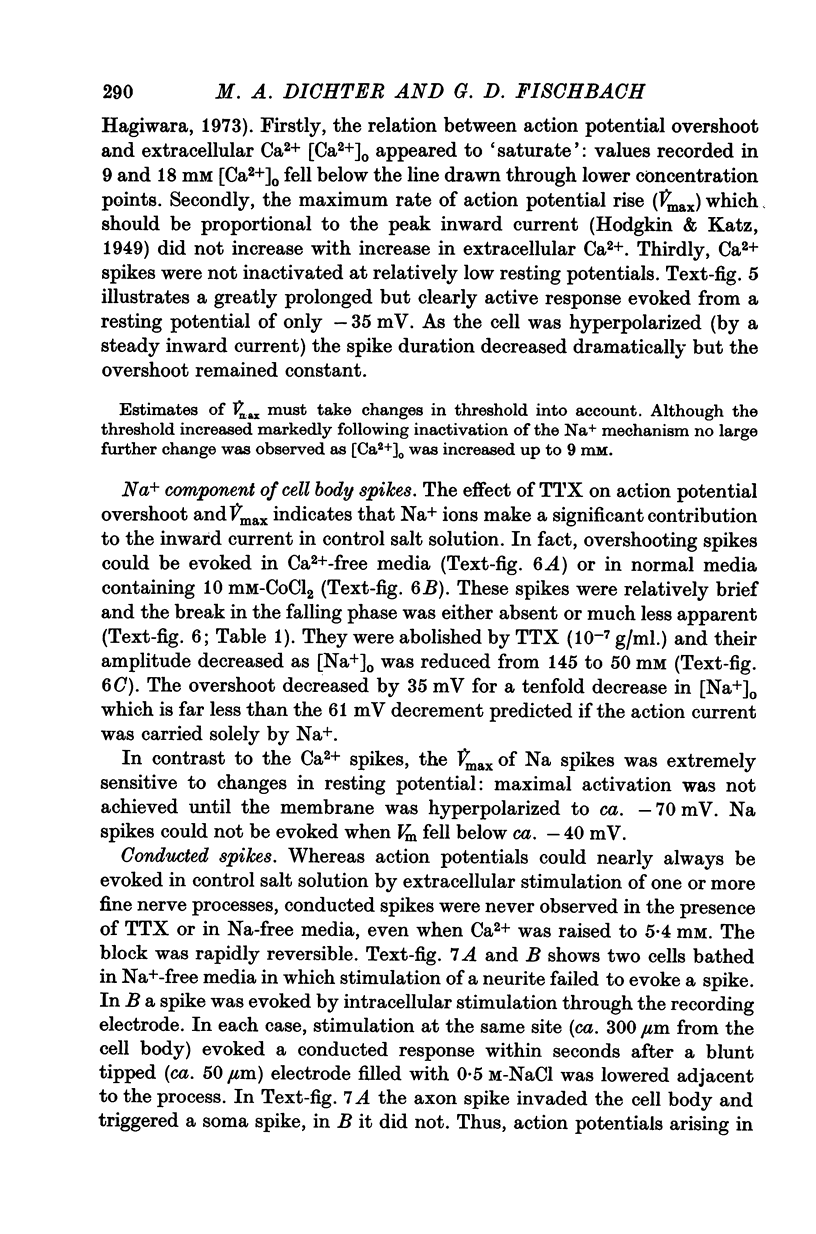
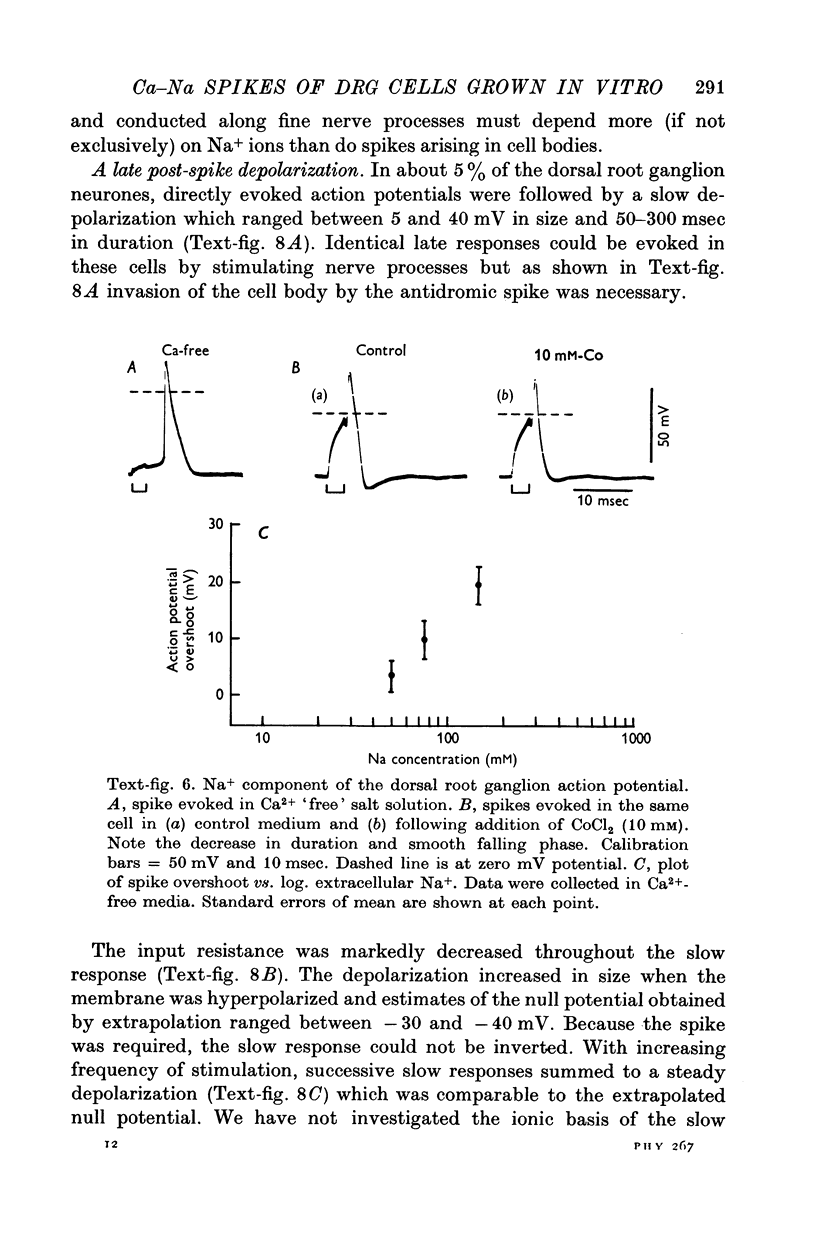

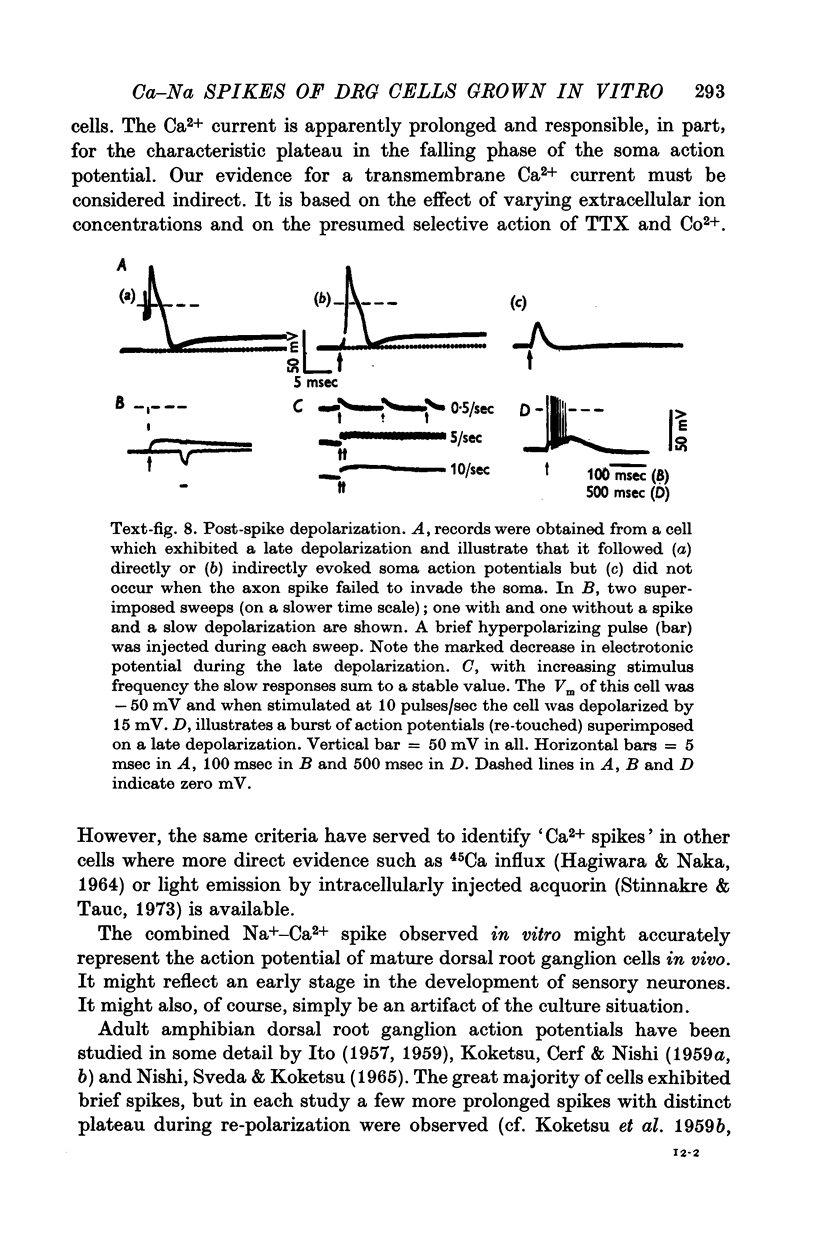



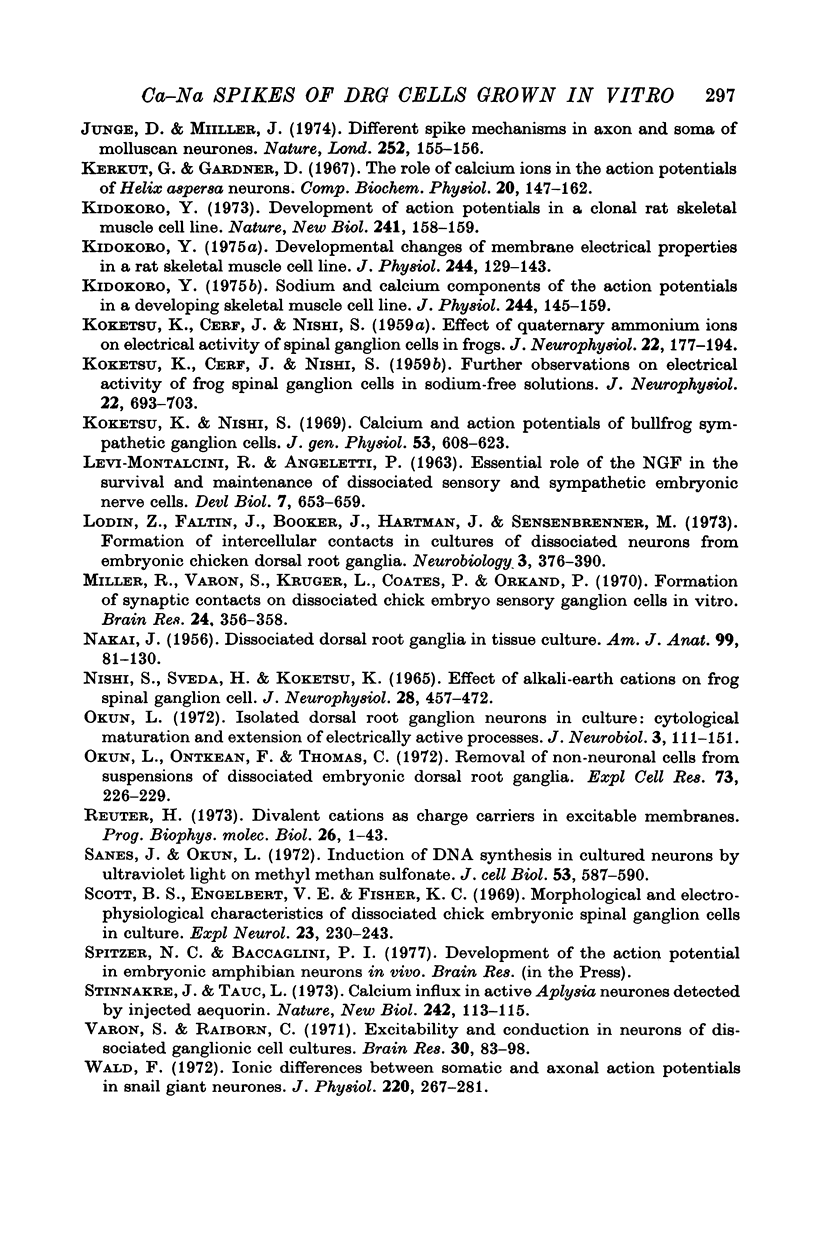



Images in this article
Selected References
These references are in PubMed. This may not be the complete list of references from this article.
- Baker P. F. Transport and metabolism of calcium ions in nerve. Prog Biophys Mol Biol. 1972;24:177–223. doi: 10.1016/0079-6107(72)90007-7. [DOI] [PubMed] [Google Scholar]
- Burnham P., Raiborn C., Varon S. Replacement of nerve-growth factor by ganglionic non-neuronal cells for the survival in vitro of dissociated ganglionic neurons. Proc Natl Acad Sci U S A. 1972 Dec;69(12):3556–3560. doi: 10.1073/pnas.69.12.3556. [DOI] [PMC free article] [PubMed] [Google Scholar]
- CRAIN S. M. Resting and action potentials of cultured chick embryo spinal ganglion cells. J Comp Neurol. 1956 Apr;104(2):285–329. doi: 10.1002/cne.901040207. [DOI] [PubMed] [Google Scholar]
- Fischbach G. D., Dichter M. A. Electrophysiologic and morphologic properties of neurons in dissociated chick spinal cord cell cultures. Dev Biol. 1974 Mar;37(1):100–116. doi: 10.1016/0012-1606(74)90172-9. [DOI] [PubMed] [Google Scholar]
- Fischbach G. D. Synapse formation between dissociated nerve and muscle cells in low density cell cultures. Dev Biol. 1972 Jun;28(2):407–429. doi: 10.1016/0012-1606(72)90023-1. [DOI] [PubMed] [Google Scholar]
- Geduldig D., Gruener R. Voltage clamp of the Aplysia giant neurone: early sodium and calcium currents. J Physiol. 1970 Nov;211(1):217–244. doi: 10.1113/jphysiol.1970.sp009276. [DOI] [PMC free article] [PubMed] [Google Scholar]
- Geduldig D., Junge D. Sodium and calcium components of action potentials in the Aplysia giant neurone. J Physiol. 1968 Dec;199(2):347–365. doi: 10.1113/jphysiol.1968.sp008657. [DOI] [PMC free article] [PubMed] [Google Scholar]
- HAGIWARA S., NAKA K. I. THE INITIATION OF SPIKE POTENTIAL IN BARNACLE MUSCLE FIBERS UNDER LOW INTRACELLULAR CA++. J Gen Physiol. 1964 Sep;48:141–162. doi: 10.1085/jgp.48.1.141. [DOI] [PMC free article] [PubMed] [Google Scholar]
- HODGKIN A. L., KATZ B. The effect of sodium ions on the electrical activity of giant axon of the squid. J Physiol. 1949 Mar 1;108(1):37–77. doi: 10.1113/jphysiol.1949.sp004310. [DOI] [PMC free article] [PubMed] [Google Scholar]
- Hagiwara S. Ca spike. Adv Biophys. 1973;4:71–102. [PubMed] [Google Scholar]
- Hirst G. D., Spence I. Calcium action potentials in mammalian peripheral neurones. Nat New Biol. 1973 May 9;243(123):54–56. [PubMed] [Google Scholar]
- ITO M. An analysis of potentials recorded intracellularly from the spinal ganglion cell. Jpn J Physiol. 1959 Mar 25;9(1):20–32. doi: 10.2170/jjphysiol.9.20. [DOI] [PubMed] [Google Scholar]
- ITO M. The electrical activity of spinal ganglion cells investigated with intracellular microelectrodes. Jpn J Physiol. 1957 Dec 20;7(4):297–323. doi: 10.2170/jjphysiol.7.297. [DOI] [PubMed] [Google Scholar]
- Iwasaki S., Satow Y. Sodium- and calcium-dependent spike potentials in the secretory neuron soma of the X-organ of the crayfish. J Gen Physiol. 1971 Feb;57(2):216–236. doi: 10.1085/jgp.57.2.216. [DOI] [PMC free article] [PubMed] [Google Scholar]
- Junge D., Miller J. Different spike mechanisms in axon and soma of molluscan neurone. Nature. 1974 Nov 8;252(5479):155–156. doi: 10.1038/252155a0. [DOI] [PubMed] [Google Scholar]
- KOKETSU K., CERF J. A., NISHI S. Effect of quaternary ammonium ions on electrical activity of spinal ganglion cells in frogs. J Neurophysiol. 1959 Mar;22(2):177–194. doi: 10.1152/jn.1959.22.2.177. [DOI] [PubMed] [Google Scholar]
- KOKETSU K., CERF J. A., NISHI S. Further observations on electrical activity of frog spinal ganglion cells in sodium-free solutions. J Neurophysiol. 1959 Nov;22:693–703. doi: 10.1152/jn.1959.22.6.693. [DOI] [PubMed] [Google Scholar]
- Kidokoro Y. Development of action potentials in a clonal rat skeletal muscle cell line. Nat New Biol. 1973 Jan 31;241(109):158–159. doi: 10.1038/newbio241158a0. [DOI] [PubMed] [Google Scholar]
- Kidokoro Y. Developmental changes of membrane electrical properties in a rat skeletal muscle cell line. J Physiol. 1975 Jan;244(1):129–143. doi: 10.1113/jphysiol.1975.sp010787. [DOI] [PMC free article] [PubMed] [Google Scholar]
- Kidokoro Y. Sodium and calcium components of the action potential in a developing skeletal muscle cell line. J Physiol. 1975 Jan;244(1):145–159. doi: 10.1113/jphysiol.1975.sp010788. [DOI] [PMC free article] [PubMed] [Google Scholar]
- Koketsu K., Nishi S. Calcium and action potentials of bullfrog sympathetic ganglion cells. J Gen Physiol. 1969 May;53(5):608–623. doi: 10.1085/jgp.53.5.608. [DOI] [PMC free article] [PubMed] [Google Scholar]
- LEVI-MONTALCINI R., ANGELETTI P. U. Essential role of the nerve growth factor in the survival and maintenance of dissociated sensory and sympathetic embryonic nerve cells in vitro. Dev Biol. 1963 Mar;6:653–659. doi: 10.1016/0012-1606(63)90149-0. [DOI] [PubMed] [Google Scholar]
- Miller R., Varon S., Kruger L., Coates P. W., Orkand P. M. Formation of synaptic contacts on dissociated chick embryo sensory ganglion cells in vitro. Brain Res. 1970 Dec 1;24(2):356–358. doi: 10.1016/0006-8993(70)90119-8. [DOI] [PubMed] [Google Scholar]
- NAKAI J. Dissociated dorsal root ganglia in tissue culture. Am J Anat. 1956 Jul;99(1):81–129. doi: 10.1002/aja.1000990105. [DOI] [PubMed] [Google Scholar]
- NISHI S., SOEDA H., KOKETSU K. EFFECT OF ALKALI-EARTH CATIONS ON FROG SPINAL GANGLION CELL. J Neurophysiol. 1965 May;28:457–472. doi: 10.1152/jn.1965.28.3.457. [DOI] [PubMed] [Google Scholar]
- Okun L. M. Isolated dorsal root ganglion neurons in culture: cytological maturation and extension of electrically active processes. J Neurobiol. 1972;3(2):111–151. doi: 10.1002/neu.480030203. [DOI] [PubMed] [Google Scholar]
- Okun L. M., Ontkean F. K., Thomas C. A., Jr Removal of non-neuronal cells from suspensions of dissociated embryonic dorsal root ganglia. Exp Cell Res. 1972 Jul;73(1):226–229. doi: 10.1016/0014-4827(72)90123-1. [DOI] [PubMed] [Google Scholar]
- Reuter H. Divalent cations as charge carriers in excitable membranes. Prog Biophys Mol Biol. 1973;26:1–43. doi: 10.1016/0079-6107(73)90016-3. [DOI] [PubMed] [Google Scholar]
- Sanes J. R., Okun L. M. Induction of DNA synthesis in cultured neurons by ultraviolet light or methyl methane sulfonate. J Cell Biol. 1972 May;53(2):587–590. doi: 10.1083/jcb.53.2.587. [DOI] [PMC free article] [PubMed] [Google Scholar]
- Scott B. S., Engelbert V. E., Fisher K. C. Morphological and electrophysiological characteristics of dissociated chick embryonic spinal ganglion cells in culture. Exp Neurol. 1969 Feb;23(2):230–248. doi: 10.1016/0014-4886(69)90060-0. [DOI] [PubMed] [Google Scholar]
- Stinnakre J., Tauc L. Calcium influx in active Aplysia neurones detected by injected aequorin. Nat New Biol. 1973 Mar 28;242(117):113–115. doi: 10.1038/newbio242113b0. [DOI] [PubMed] [Google Scholar]
- Varon S., Raiborn C. Excitability and conduction in neurons of dissociated ganglionic cell cultures. Brain Res. 1971 Jul 9;30(1):83–98. doi: 10.1016/0006-8993(71)90007-2. [DOI] [PubMed] [Google Scholar]
- Wald F. Ionic differences between somatic and axonal action potentials in snail giant neurones. J Physiol. 1972 Jan;220(2):267–281. doi: 10.1113/jphysiol.1972.sp009706. [DOI] [PMC free article] [PubMed] [Google Scholar]




